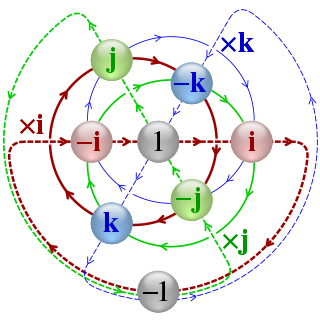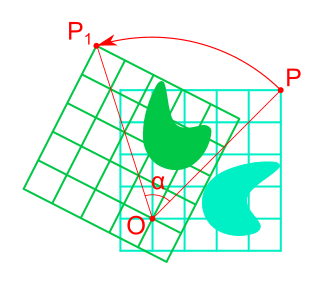| Look up quaternion in Wiktionary, the free dictionary. |
| Look up quaternion in Wiktionary, the free dictionary. |
The quaternions form a number system that extends the complex numbers.
| | This disambiguation page lists articles associated with the title Quaternion. If an internal link led you here, you may wish to change the link to point directly to the intended article. |

In mathematics, a 3-sphere, or glome, is a higher-dimensional analogue of a sphere. It may be embedded in 4-dimensional Euclidean space as the set of points equidistant from a fixed central point. Analogous to how the boundary of a ball in three dimensions is an ordinary sphere, the boundary of a ball in four dimensions is a 3-sphere. A 3-sphere is an example of a 3-manifold and an n-sphere.

Sir William Rowan Hamilton MRIA was an Irish mathematician, Andrews Professor of Astronomy at Trinity College Dublin, and Royal Astronomer of Ireland. He worked in both pure mathematics and mathematics for physics. He made important contributions to optics, classical mechanics and algebra. Although Hamilton was not a physicist–he regarded himself as a pure mathematician–his work was of major importance to physics, particularly his reformulation of Newtonian mechanics, now called Hamiltonian mechanics. This work has proven central to the modern study of classical field theories such as electromagnetism, and to the development of quantum mechanics. In pure mathematics, he is best known as the inventor of quaternions.

In mathematics, the quaternion number system extends the complex numbers. Quaternions were first described by Irish mathematician William Rowan Hamilton in 1843 and applied to mechanics in three-dimensional space. Hamilton defined a quaternion as the quotient of two directed lines in a three-dimensional space, or equivalently, as the quotient of two vectors. Multiplication of quaternions is noncommutative.

In group theory, the quaternion group Q8 (sometimes just denoted by Q) is a non-abelian group of order eight, isomorphic to the eight-element subset of the quaternions under multiplication. It is given by the group presentation

In group theory, a dicyclic group is a particular kind of non-abelian group of order 4n. It is an extension of the cyclic group of order 2 by a cyclic group of order 2n, giving the name di-cyclic. In the notation of exact sequences of groups, this extension can be expressed as:
Unit quaternions, known as versors, provide a convenient mathematical notation for representing spatial orientations and rotations of elements in three dimensional space. Specifically, they encode information about an axis-angle rotation about an arbitrary axis. Rotation and orientation quaternions have applications in computer graphics, computer vision, robotics, navigation, molecular dynamics, flight dynamics, orbital mechanics of satellites and crystallographic texture analysis.

Anne Bradstreet was the most prominent of early English poets of North America and first writer in England's North American colonies to be published. She is the first Puritan figure in American Literature and notable for her large corpus of poetry, as well as personal writings published posthumously.

Rotation in mathematics is a concept originating in geometry. Any rotation is a motion of a certain space that preserves at least one point. It can describe, for example, the motion of a rigid body around a fixed point. A rotation is different from other types of motions: translations, which have no fixed points, and (hyperplane) reflections, each of them having an entire (n − 1)-dimensional flat of fixed points in a n-dimensional space. A clockwise rotation is a negative magnitude so a counterclockwise turn has a positive magnitude.
In mathematics, a Hurwitz quaternion is a quaternion whose components are either all integers or all half-integers. The set of all Hurwitz quaternions is

An Imperial State or Imperial Estate was a part of the Holy Roman Empire with representation and the right to vote in the Imperial Diet. Rulers of these Estates were able to exercise significant rights and privileges and were "immediate", meaning that the only authority above them was the Holy Roman Emperor. They were thus able to rule their territories with a considerable degree of autonomy.
In abstract algebra, the algebra of hyperbolic quaternions is a nonassociative algebra over the real numbers with elements of the form
In abstract algebra, the biquaternions are the numbers w + xi + yj + zk, where w, x, y, and z are complex numbers, or variants thereof, and the elements of {1, i, j, k} multiply as in the quaternion group and commute with their coefficients. There are three types of biquaternions corresponding to complex numbers and the variations thereof:
In abstract algebra, the split-quaternions or coquaternions are elements of a 4-dimensional associative algebra introduced by James Cockle in 1849 under the latter name. Like the quaternions introduced by Hamilton in 1843, they form a four dimensional real vector space equipped with a multiplicative operation. But unlike the quaternions, the split-quaternions contain nontrivial zero divisors, nilpotent elements, and idempotents. As an algebra over the real numbers, they are isomorphic to the algebra of 2 × 2 real matrices. For other names for split-quaternions see the Synonyms section below.
In mathematics, a versor is a quaternion of norm one.
In mathematics, a quaternion algebra over a field F is a central simple algebra A over F that has dimension 4 over F. Every quaternion algebra becomes a matrix algebra by extending scalars, i.e. for a suitable field extension K of F, is isomorphic to the 2×2 matrix algebra over K.
In mathematics, a composition algebraA over a field K is a not necessarily associative algebra over K together with a nondegenerate quadratic form N that satisfies

In mathematics, quaternions are a non-commutative number system that extends the complex numbers. Quaternions and their applications to rotations were first described in print by Olinde Rodrigues in all but name in 1840, but independently discovered by Irish mathematician Sir William Rowan Hamilton in 1843 and applied to mechanics in three-dimensional space. They find uses in both theoretical and applied mathematics, in particular for calculations involving three-dimensional rotations.

An Imperial Eagle beaker, or eagle glass, was a popular drinking vessel from the 16th until the late 18th century in the Holy Roman Empire. The enamelled glass was decorated with a double-headed eagle, usually in the shape of a quaternion. The Reichsadler means "Imperial Eagle" or double-headed eagle which was the emblem of the empire, while "humpen" refers to a cylindrical drinking glass. These beakers became the essential medium to represent the most popular explanatory model for the emergence of the Empire: the quaternion theory as represented by Hans Burgkmair.
Quaternion is a poetry style in which the theme is divided into four parts.